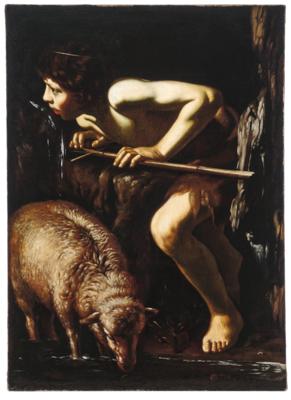School of Caravaggio, 17th Century
Saint John the Baptist at a spring,
oil on canvas, 135 x 98 cm, unframed
The composition of the present painting relates to a prototype by Caravaggio, which is at present untraced.
In early July 1610, Caravaggio left Naples for Rome to seek pardon from Pope Paul V for the murder he had committed four years earlier when he stabbed a man during a brawl. Caravaggio took with him three of his paintings as a gift for Cardinal Scipione Borghese: a Penitent Magdalene, a Saint John in the Desert and a Saint John the Baptist at a spring. Arriving in Palo, the painter was arrested for a brief period and shortly after having been released, he was found dead in Porto Ercole. The "felucca" (a traditional wooden sailing boat), in which Caravaggio travelled, returned to Naples with the three canvases on board; the Saint John in the Desert was sent to the Cardinal sometime later and is today still conserved in the Galleria Borghese in Rome. The other two works are considered lost (see V. Pacelli, La morte del Caravaggio e alcuni suoi dipinti da documenti inediti, in: Studi di Storia dell’Arte, 1991, no. 2, pp. 167–188).
Caravaggio’s Saint John the Baptist at a spring was probably painted in Naples in 1609–1610 and entered the collection of the Viceroy, Pietro Fernandez de Castro, Duke of Lemos where it was seen and copied by numerous artists. Among the known derivations, some with significant variants, are the work, recorded in a photograph in the Kunsthistorisches Museum, Vienna (inv. no. WOLFRUM_1117), for which an attribution to Pedro de Orrente has been proposed; the painting in Plasencia Cathedral, possibly by Alonso Rodriguez from Messina (Naples documented 1605–1611); and other versions in private collections, for which attributions to Filippo Vitale and Battistello Caracciolo have been suggested.
The present work can be closely compared to the painting of the same subject exhibited at the Caravaggio exhibition in Naples in 2004 (oil on canvas, 127 x 95 cm; see S. Schütze, Caravaggio. Das vollständige Werk, Cologne 2015, pp. 295–296, fig. 83b), which also features the detail of the finely painted golden halo, which is absent in all other known versions.
Specialist: Mark MacDonnell
 Mark MacDonnell
Mark MacDonnell
+43 1 515 60 403
old.masters@dorotheum.com
24.04.2024 - 18:00
- Estimate:
-
EUR 100,000.- to EUR 150,000.-
Follow Remove
School of Caravaggio, 17th Century
Saint John the Baptist at a spring,
oil on canvas, 135 x 98 cm, unframed
The composition of the present painting relates to a prototype by Caravaggio, which is at present untraced.
In early July 1610, Caravaggio left Naples for Rome to seek pardon from Pope Paul V for the murder he had committed four years earlier when he stabbed a man during a brawl. Caravaggio took with him three of his paintings as a gift for Cardinal Scipione Borghese: a Penitent Magdalene, a Saint John in the Desert and a Saint John the Baptist at a spring. Arriving in Palo, the painter was arrested for a brief period and shortly after having been released, he was found dead in Porto Ercole. The "felucca" (a traditional wooden sailing boat), in which Caravaggio travelled, returned to Naples with the three canvases on board; the Saint John in the Desert was sent to the Cardinal sometime later and is today still conserved in the Galleria Borghese in Rome. The other two works are considered lost (see V. Pacelli, La morte del Caravaggio e alcuni suoi dipinti da documenti inediti, in: Studi di Storia dell’Arte, 1991, no. 2, pp. 167–188).
Caravaggio’s Saint John the Baptist at a spring was probably painted in Naples in 1609–1610 and entered the collection of the Viceroy, Pietro Fernandez de Castro, Duke of Lemos where it was seen and copied by numerous artists. Among the known derivations, some with significant variants, are the work, recorded in a photograph in the Kunsthistorisches Museum, Vienna (inv. no. WOLFRUM_1117), for which an attribution to Pedro de Orrente has been proposed; the painting in Plasencia Cathedral, possibly by Alonso Rodriguez from Messina (Naples documented 1605–1611); and other versions in private collections, for which attributions to Filippo Vitale and Battistello Caracciolo have been suggested.
The present work can be closely compared to the painting of the same subject exhibited at the Caravaggio exhibition in Naples in 2004 (oil on canvas, 127 x 95 cm; see S. Schütze, Caravaggio. Das vollständige Werk, Cologne 2015, pp. 295–296, fig. 83b), which also features the detail of the finely painted golden halo, which is absent in all other known versions.
Specialist: Mark MacDonnell
 Mark MacDonnell
Mark MacDonnell
+43 1 515 60 403
old.masters@dorotheum.com
|
Buyers hotline
Mon.-Fri.: 10.00am - 5.00pm
old.masters@dorotheum.at +43 1 515 60 403 |
| Auction: | Old Master Paintings |
| Auction type: | Saleroom auction with Live Bidding |
| Date: | 24.04.2024 - 18:00 |
| Location: | Vienna | Palais Dorotheum |
| Exhibition: | 13.04. - 24.04.2024 |

